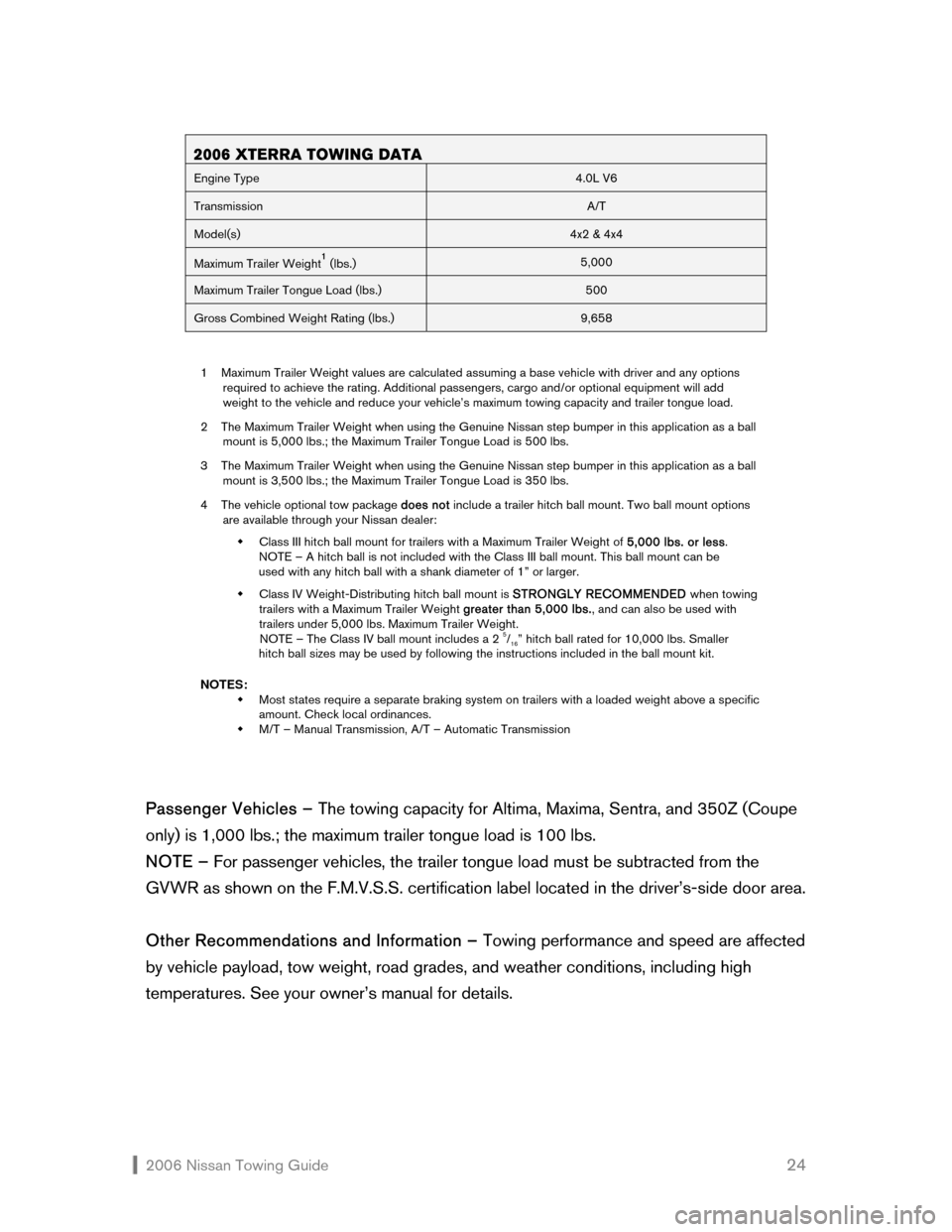2006 NISSAN MURANO check engine
[x] Cancel search: check enginePage 15 of 28

2006 Nissan Towing Guide 14 TIRE PRESSURE
When towing a trailer, increase tow vehicle tire pressures to the recommended cold
specifications. You’ll find these figures in the owner’s manual and on the tire pressure chart
located in the vehicle. Trailer tire condition, size, load rating, and inflation pressure should
be in accordance with the trailer and tire manufacturer’s specifications.
TOWING
SAFETY
Towing can dramatically alter the handling and performance characteristics of your vehicle.
Plus, it puts increased strain on the engine and drivetrain. Therefore, it is always a good
idea to approach towing from the standpoint of safety — whether you’re purchasing
equipment or actually pulling the trailer.
Always make sure your vehicle’s towing capacity is adequate for the trailer you intend to
tow. Buy or lease only quality equipment, and have it installed only by professionals.
In addition, be certain that you have all of the equipment needed for safe towing,
including safety chains/cables, electric trailer brakes, electric trailer brake controller,
breakaway switch, extended rear view mirrors, and so on. All of these items have been
discussed in a previous section of this guide.
With regard to vehicle maintenance, you should follow a more frequent schedule, and
check fluid levels, pressures, tire condition, etc., more often when on the road. See your
owner’s manual for details.
LOADING YOUR TRAILER
Taking the time to load and balance your trailer properly will improve overall handling and
minimize the strain on your tow vehicle. Incorrectly loaded trailers tend to sway or swing
from side to side, upsetting vehicle handling. Careful loading and balancing can help
eliminate these problems.
As mentioned earlier, conventional trailer tongue load should fall between 10-15% of
the total trailer weight, and king pin load — if using a 5th wheel or gooseneck trailer —
should be between 15-25% of the total trailer weight. Excessive tongue/king pin load can
actually push the vehicle down in back, lifting the front wheels to a point where traction,
steering response, and braking are severely reduced. Insufficient tongue/king pin load can
cause instability, which may lead to “tail wagging” or jackknifing.
Page 17 of 28

2006 Nissan Towing Guide 16 VEHICLE SPEED
Some states have specific regulations and speed limits for vehicles that are towing trailers.
Always obey these ordinances. Remember to reduce your speed in unsafe or less-than-
ideal road conditions or weather. When towing a trailer, braking distances increase while
handling agility decreases. Always leave yourself an extra margin of distance to respond to
emergency situations.
PASSENGERS
Never allow passengers to ride inside a trailer while it is being towed. Not only is this
unlawful in most areas, passengers could be seriously injured during sudden trailer
movement or in an accident. In addition, trailers may allow fumes from the tow vehicle to
leak inside. This could result in carbon monoxide poisoning from the engine exhaust.
VEHICLE MODIFICATIONS
Vehicle modifications — beyond those required for proper hitch installation, wiring hook-up,
and necessary cooling system upgrading — are not recommended for any Nissan vehicle
being used for towing purposes. Changes to the drivetrain, suspension, exhaust systems,
frame structure/unibody, or other vehicle components are not necessary for towing within
the limits described in this guide. These changes may diminish the reliability and longevity
of your vehicle and possibly void warranty coverage as well.
TOOL KIT
It is always a good idea to travel with a special tool kit when towing. In addition to tools, it
should contain flares, a flashlight, emergency reflectors, jumper cables, extra fuses, extra
radiator coolant, oil, and easily replaced spare parts such as taillight bulbs. You should also
carry spare tires for your tow vehicle and trailer, as well as a jack suitable for use on the
trailer. Be aware that not all automotive jacks can be used safely on a trailer.
BEFORE STARTING OUT
Before starting out on a trip, make one last inspection of the tow vehicle and the trailer. Are
the tire pressures correct? Are the safety chains/cables securely in place? Is the cargo tied
down securely? Do all the lights work? Is the coupler properly attached over the hitch ball
and secured using a locking pin? Is the breakaway switch hooked up and functioning
properly? Are vehicle and electric trailer brakes working properly?
Make a checklist of key items to be inspected, and don’t forget the basics. When
towing, vehicle engine oil, transmission oil, and coolant should always be checked before
starting out. Finding a potential problem while in your driveway is better than discovering it
miles from home.
Page 21 of 28

2006 Nissan Towing Guide 20 2. Turn off the air conditioning and, after opening all the windows, turn the heater on to
maximum hot and the fan to its highest speed. The heater core in your vehicle is just
like a miniature engine radiator and will provide an extra cooling surface to help reduce
engine temperature.
3. Run the engine at a fast idle (approximately 1,500 rpm) until the temperature gauge
returns to a normal reading. If the temperature does not drop or continues to increase,
stop this step immediately.
4. Being cautious of traffic, step out of the vehicle and, from a safe distance, look for
steam underneath the engine. If you see steam or leaking coolant, stand clear to avoid
being burned. Shut off your engine immediately and allow it to cool. If there is no steam,
open the hood. Never remove the radiator cap when the radiator is hot. If the cap is
removed under these conditions, hot water under high pressure may spurt out, possibly
causing serious injury.
5. As soon as the engine has cooled to its normal operating temperature, visually inspect
the drive belts for damage or looseness. A loose belt reduces water pump efficiency.
Be careful to keep your hands, hair, jewelry, and clothing clear of the running drive belt
and other moving parts when inspecting the engine and radiator. Also check to see if
the cooling fan is running, and inspect the water pump, radiator, and radiator hoses for
leaks. Keep in mind, too, that if your vehicle is equipped with an electric fan motor, it
may start without warning any time the coolant temperature is high. If you find leaking
coolant, a loose or missing drive belt, or an inoperable fan, turn the engine off
immediately.
6. If no leaks are apparent and all other components appear to be operating properly with
the engine cooled to its normal operating temperature, check the coolant level in the
reservoir tank with the engine running. Add coolant to the reservoir tank if needed. At
this point, if repairs are required, go to the nearest Nissan dealer. See the IN CASE OF
EMERGENCY section of your owner’s manual for additional information on overheating.
NOTE – Armada, Frontier, Pathfinder, Titan, and Xterra vehicles have an engine protection
mode which helps reduce the chance of engine damage if the engine coolant reaches a
specified temperature. The Murano has a high fluid temperature protection mode which
helps to reduce the chance of transmission damage. See your owner’s manual for details.
Page 25 of 28

2006 Nissan Towing Guide 24
Passenger Vehicles – The towing capacity for Altima, Maxima, Sentra, and 350Z (Coupe
only) is 1,000 lbs.; the maximum trailer tongue load is 100 lbs.
NOTE – For passenger vehicles, the trailer tongue load must be subtracted from the
GVWR as shown on the F.M.V.S.S. certification label located in the driver’s-side door area.
Other Recommendations and Information – Towing performance and speed are affected
by vehicle payload, tow weight, road grades, and weather conditions, including high
temperatures. See your owner’s manual for details.
2006 XTERRA TOWING DATA
Engine Type 4.0L V6
Transmission A/T
Model(s) 4x2 & 4x4
Maximum Trailer Weight1 (lbs.) 5,000
Maximum Trailer Tongue Load (lbs.) 500
Gross Combined Weight Rating (lbs.) 9,658
1 Maximum Trailer Weight values are calculated assuming a base vehicle with driver and any options
required to achieve the rating. Additional passengers, cargo and/or optional equipment will add
weight to the vehicle and reduce your vehicle’s maximum towing capacity and trailer tongue load.
2 The Maximum Trailer Weight when using the Genuine Nissan step bumper in this application as a ball
mount is 5,000 lbs.; the Maximum Trailer Tongue Load is 500 lbs.
3 The Maximum Trailer Weight when using the Genuine Nissan step bumper in this application as a ball
mount is 3,500 lbs.; the Maximum Trailer Tongue Load is 350 lbs.
4 The vehicle optional tow package does not include a trailer hitch ball mount. Two ball mount options
are available through your Nissan dealer:
�Š Class III hitch ball mount for trailers with a Maximum Trailer Weight of 5,000 lbs. or less.
NOTE – A hitch ball is not included with the Class III ball mount. This ball mount can be
used with any hitch ball with a shank diameter of 1” or larger.
�Š Class IV Weight-Distributing hitch ball mount is STRONGLY RECOMMENDED when towing
trailers with a Maximum Trailer Weight greater than 5,000 lbs., and can also be used with
trailers under 5,000 lbs. Maximum Trailer Weight.
NOTE – The Class IV ball mount includes a 2 5/16” hitch ball rated for 10,000 lbs. Smaller
hitch ball sizes may be used by following the instructions included in the ball mount kit.
NOTES:
�Š Most states require a separate braking system on trailers with a loaded weight above a specific
amount. Check local ordinances.
�Š M/T – Manual Transmission, A/T – Automatic Transmission